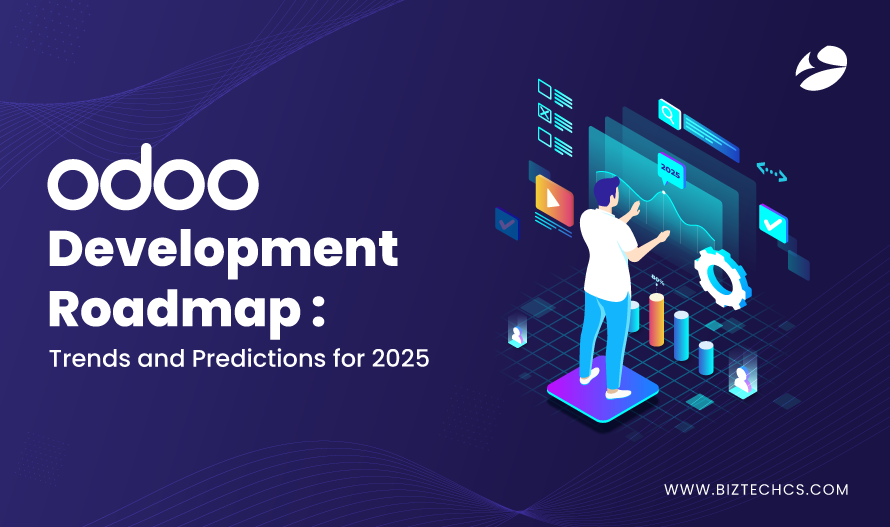5510
The Future of Odoo Development: Trends Every Business Should Watch
5 min read
5510
5 min read
Table of Content

Odoo has quickly become one of the most comprehensive open-source ERP systems that revolutionized business management with its modularity and intuitive interface. Looking forward to 2025, the development roadmap is even more interesting with trends such as AI automation, further flexibility, and the introduction of cloud solutions.
The global ERP software market is predicted to reach $78.4 billion by 2026 (source: Grand View Research), underscoring the rising demand for platforms like Odoo. With over 7 million users worldwide, it is clear that businesses continue to invest heavily in this platform.
Today’s developers are already pushing the boundaries of integration possibilities and introducing specialized modules, raising the bar for innovation. As a result, Odoo development services are in high demand to cater to these advanced needs, helping businesses stay competitive and adaptable.
Thus, it remains critical for companies to explore new ways to maintain their edge in Odoo development as technology progresses quickly.
In this blog, we will try to comprehend trends that define the future development of Odoo and make predictions of what is possible in 2025.
Odoo ERP is a business management tool that enables businesses to effectively manage various aspects of their businesses. It provides them with a series of applications to cater to their needs in accounting, sales, inventory tracking, and managing employees.
Companies can select the particular applications that are required and adapt them to the requirements of the business.
Odoo has a relatively excellent user interface, making it easy for employees to understand the changes that need to be made.
They enhance the automation of activities, thus reducing manual efforts and the possibility of making mistakes. It can apply to small start-ups as well as big companies and corporations. Odoo is an open-source software, which means that its necessary features can be modified and users can contribute new features.
Odoo ERP is evolving because business organizations require more flexibility and individuality to address their requirements.
Over time, new features appear in technology, and Odoo implements new features into its software to enhance compatibility with other tools. This also aids user experience enhancement since using the platform becomes easier.
Even as a leading open-source ERP software, Odoo will listen to its users, as the latter will determine its updates and new modules.
The advancement of working from home and digital processes challenges Odoo to offer better cloud services. The reason is it has a system of continuous development and enhancement of its various potentials to remain significant where significant changes occur constantly.
An emerging trend in Odoo development is the usage of Artificial Intelligence (AI) and Machine Learning (ML) to make operations smarter and more effective.
These include avoiding repetitive tasks in that it only requires input once for the computer to accomplish the task on its own.
The application of artificial intelligence in demand forecasting assists in better estimation of market requirements, enhancing pricing efficiency and minimizing inventory exhaustion.
In customer service, artificial intelligence in chatbots and automation is more efficient in replying to customers.
Notably, ML can also enhance marketing strategies by divulging customer behavior, thus achieving suitable and precise campaigns. In sum, this trend improves decision-making and enhances smooth working within the Odoo systems in businesses.
One essential trend in Odoo development is the introduction of new cloud-based ERP options. Odoo operates on the Software as a Service (SaaS) model, which ensures users can access the platform through web browsers without extensive installation procedures on-site.
It also has more apparent advantages, such as scalability to accommodate growing numbers of business transactions, less investment in hardware requirements, and better access from any location.
Subsequent releases of the software are likely to enhance Odoo’s scalability so that organizations can easily accommodate growing volumes of data.
The processing of personal data will be more secure, ensuring users’ privacy, which has been an issue in the past.
Another expected future feature is compatibility with other cloud services to improve efficiency and linkages for users. As businesses continue to grow, it may be beneficial to hire Odoo developers to integrate these advanced features and ensure that your business stays ahead in terms of technology and security.
Another developing trend in Odoo development is improving the interface and bringing the application to the devices on mobile platforms.
Developers are working on more responsive designs and applications that will integrate well with the rest of the Odoo environment. This means that users can well organize their work, control their efficiency, and communicate with co-workers through tablets or mobile phones.
Mobile-friendly interfaces will help businesses promote productivity and achieve and sustain high levels of operations mobility. This trend is about ensuring that people who work with Odoo’s powerful tools can do it as efficiently and without any inconvenience on a mobile device as on a regular computer.
Therefore, users get the independence of making calls and being in command of what is happening anywhere.
One of the major developments observed in the Odoo world is the increasing effort to customize the system more and enhance usability.
Additional changes to Odoo would make the system’s modular structure even more flexible, as businesses can already tailor it to their needs.
Businesses can expect more flexible modules within their structures than currently available. Possible integrations with other applications will be made more accessible, meaning incorporating one tool will present fewer challenges.
There is also an emphasis on improving the means by which developers can create bespoke solutions that require little work. Lastly, Odoo’s vision is to improve the usability of its interface and the patterns inherent to the processes supported by it.
Odoo is introducing new technologies such as the Internet of Things (IoT) and blockchain to stay competitive. This can be done by incorporating IoT sensors through which different business processes like production or supply chain can be monitored in real-time within the Odoo platform.
This enhances visibility and accountability; the carefully designed structure enhances decision-making and operational efficiency. Incorporating blockchain technology can take it a notch higher in enhancing security and efficiency in business transactions and logistics.
All of these enhancements contribute to making Odoo a more suitable solution for today’s business requirements based on trust and data integrity. Hence, this trend showcases Odoo’s willingness to adapt to industry needs and technological advancements.
1. Scalability and Performance Issues
When businesses expand and data volumes in Odoo applications rise, system performance becomes critical not to crash and/or slow down.
When scaling Odoo safely and without trading off on speed, performance optimization is necessary, with specific emphasis on the database.
Large customizations involve several steps that, if implemented unsystematically, could complicate the processes and even slow the operations.
It also exhibits system responsiveness in that efficient performance is achieved even with many custom features being coded and integrated.
2. Compatibility and Integration
One critical challenge companies face when using a combination of software is assuring compatibility with third-party tools such as SAP, Microsoft Dynamics, and other SaaS solutions.
Integration issues can also create flow interferences and thus require the development of adaptable integration strategies.
Another issue is the possibility of updating to new software versions, keeping compatibility with the previous versions; businesses require seamless transition with no disruptions in their work.
Thus, addressing the mentioned aspects minimizes user skepticism and disruption of operations during updates.
3. User Experience (UX) Improvements
This is one of the biggest problems in Odoo because it is complicated to configure in some modules and the users need to gain technical knowledge. It becomes quite challenging to simplify these interfaces but make them retain all these functionalities.
It is also challenging to make the design of many modules consistent as most originate from community members. This is not very beneficial to the user experience since they have to be aligned to make more sense.
4. Security and Data Privacy Concerns
Odoo needs to continue watching the changes in data regulations such as GDPR and CCPA for its clients to adhere to as most of them operate in different zones.
One drawback is that, as being open source, Odoo has more eyes on it that can try to hack it and, therefore, requires more precautions when it comes to data protection.
It is important to quickly detect and respond to security risks to avoid compromising users’ data.
Another aspect that enables Odoo to meet users’ privacy needs is the company’s attention to security and compliance.
5. Cloud Infrastructure and SaaS Model
Odoo Online must continuously improve its cloud infrastructure to stay competitive by offering faster performance, reliable uptime, and cost-efficient solutions.
Balancing these cloud optimizations with the demand for on-premise deployment requires building features that work seamlessly in both environments. This ensures customers have flexible options while maintaining consistent functionality.
By enhancing both cloud and on-premise experiences, Odoo can cater to diverse business needs effectively.
The upcoming year 2025 is expected to bring significant growth in Odoo’s development in terms of AI capabilities, integrated features, and modularity.
Some of the concerns outlined above warn the platform that it must continue to emphasize usability and introduce automation mechanisms so that it can be used not only by large enterprises but also by small and medium-sized businesses.
It is possible to note the increased emphasis on decentralization and strengthened protection of data and additional focus on various industry solutions.
Open source will not only facilitate more technological advancement in Odoo but also unveil more flexibility to develop the best changes that are more suitable for Odoo’s system.
As more companies begin looking for flexible ERP systems, Odoo cloud and improved mobility features will enable it to support remote and flexible working environments.
Thus, identifying and tracking these trends will allow firms to remain relevant and get the maximum value out of their ERP systems.
If you want to implement Odoo ERP for your organization, our team of skilled Odoo developers is ready to assist. With our expertise in Odoo ERP development, you will be well-prepared for future competition as we ensure that your ERP is developed with your specific requirements and needs in mind.
An Odoo Development Roadmap outlines the planned features, enhancements, and milestones for future Odoo releases. It serves as a strategic plan to guide the ongoing evolution of the platform, focusing on user needs, technology integration, and market demands.
Key trends in Odoo development for 2025 include enhanced AI-driven automation for business processes and deeper integration with IoT devices. Additionally, there is a growing focus on enhancing the user experience with intuitive interfaces and advanced customization capabilities using low-code/no-code tools.
Potential challenges in Odoo development for 2025 involve maintaining robust security measures as the platform scales and ensuring compatibility with rapidly changing third-party technologies. Another concern is providing seamless, scalable customizations that do not compromise system performance or upgrades.
The benefits of these trends for businesses include improved productivity through automation and personalized software solutions tailored to specific operational needs. Moreover, better integrations and intuitive tools empower companies to adapt quickly to market changes and foster innovation without extensive technical overhead.

Artificial Intelligence (AI)
72
By Biztech Editor

Odoo
85
By Uttam Jain

Artificial Intelligence (AI)
82
By Biztech Editor